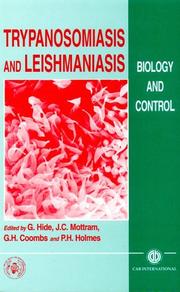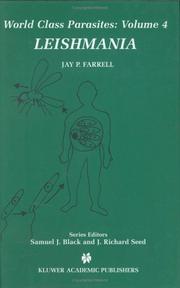| Listing 1 - 10 of 59 | << page >> |
Sort by
|
Book
Year: 2022 Publisher: London : IntechOpen,
Abstract | Keywords | Export | Availability | Bookmark
 Loading...
Loading...Choose an application
- Reference Manager
- EndNote
- RefWorks (Direct export to RefWorks)
Leishmaniasis is a major global health challenge, affecting approximately 12 million of the poorest people in 100 countries. It is a deforming and fatal disease in the visceral form. Therapies for leishmaniasis are numerically restricted, basically consisting of the administration of miltefosine, pentavalent antimonials, amphotericin B, or pentamidine. This is an important vulnerability against therapy efficiency that must be overcome by the scientific community. This book discusses important aspects of the disease, such as treatment, epidemiology, and molecular and cell biology. The information contained herein is important for young researchers as they seek to develop safe and effective treatments for this neglected tropical disease.
Book
Year: 2022 Publisher: London : IntechOpen,
Abstract | Keywords | Export | Availability | Bookmark
 Loading...
Loading...Choose an application
- Reference Manager
- EndNote
- RefWorks (Direct export to RefWorks)
Leishmaniasis is a major global health challenge, affecting approximately 12 million of the poorest people in 100 countries. It is a deforming and fatal disease in the visceral form. Therapies for leishmaniasis are numerically restricted, basically consisting of the administration of miltefosine, pentavalent antimonials, amphotericin B, or pentamidine. This is an important vulnerability against therapy efficiency that must be overcome by the scientific community. This book discusses important aspects of the disease, such as treatment, epidemiology, and molecular and cell biology. The information contained herein is important for young researchers as they seek to develop safe and effective treatments for this neglected tropical disease.
Book
Year: 2022 Publisher: London : IntechOpen,
Abstract | Keywords | Export | Availability | Bookmark
 Loading...
Loading...Choose an application
- Reference Manager
- EndNote
- RefWorks (Direct export to RefWorks)
Leishmaniasis is a major global health challenge, affecting approximately 12 million of the poorest people in 100 countries. It is a deforming and fatal disease in the visceral form. Therapies for leishmaniasis are numerically restricted, basically consisting of the administration of miltefosine, pentavalent antimonials, amphotericin B, or pentamidine. This is an important vulnerability against therapy efficiency that must be overcome by the scientific community. This book discusses important aspects of the disease, such as treatment, epidemiology, and molecular and cell biology. The information contained herein is important for young researchers as they seek to develop safe and effective treatments for this neglected tropical disease.
Book
Year: 2015 Publisher: Bruxelles: UCL. Faculté de pharmacie et des sciences biomédicales,
Abstract | Keywords | Export | Availability | Bookmark
 Loading...
Loading...Choose an application
- Reference Manager
- EndNote
- RefWorks (Direct export to RefWorks)
La leishmaniose canine est une maladie très grave, souvent mortelle. Elle est causée par un parasite, Leishmania, et transmise par un insecte hématophage, le phlébotome. C’est une maladie qui fait chaque année de nombreuses victimes. Elle touche essentiellement les chiens mais s’étend également à l’homme, elle a donc un caractère zoonotique. La leishmaniose canine se distribue en Amérique Latine, en Asie, au Moyen-Orient, en Afrique et au niveau du bassin méditerranéen. Elle commence à s’étendre à d’autres régions qui n’étaient pas endémiques auparavant, suite au réchauffement climatique. Elle se manifeste sous trois formes : la leishmaniose cutanée, responsable des lésions cutanées, la leishmaniose muco-cutanée (cavités naso-pharyngées), et la leishmaniose c viscérale (appelée également kala-azar, atteinte des organes). Les chiens ne répondent plus tout de la manière face à l’infection. Certains vont développer des symptômes plus vite que d’autres. Cela dépend du patrimoine génétique et du système immunitaire de chaque hôte mais le diagnostic peut détecter la maladie. Le diagnostic clinique n’est pas suffisant. Il est préférable d’opter pour le diagnostic de laboratoire (détection du parasite à partir d’échantillons). La prévention est cruciale. Elle peut se faire grâce aux insecticides et à la vaccination. Quant aux traitements, ils permettent de soulager les symptômes cliniques mais ne permettent toutefois pas d’éradiquer le parasite. Canine leishmaniasis is a serious illness, often followed by death. It is caused by a parasite,Leishmania, and transmitted by a bloodsucking insect (sandfly). Every year, many animals contract this disease affecting mostly dogs but the human being can also be concerned, it is a zoonotic disease. Canine leishmaniasis is found in Latina America., in Asia, in The Middle East, in Africa and around the Mediterranean area and is even spreading now to other regions which were not used to be concerned by this problem. There are visceral leishmaniasis (also called kala-azar). Dog don’t react the same way to infection. Some of them will develop symptoms more quickely than others. It depends on their immune systems and genetic background. A diagnosis enables the veterinary to detect the disease. A clinic diagnosis is not enough that’s why is better to use a laboratory diagnosis (which will detect the parasite by samples). Prevention is crucial and can be done thanks to insecticides or vaccines. Treatments can relieve symptoms but can’t eradicate the disease.

ISBN: 0851991394 Year: 1997 Publisher: Wallingford : CAB international,
Abstract | Keywords | Export | Availability | Bookmark
 Loading...
Loading...Choose an application
- Reference Manager
- EndNote
- RefWorks (Direct export to RefWorks)
Book
ISBN: 1839680822 1839680814 Year: 2022 Publisher: London, England : IntechOpen,
Abstract | Keywords | Export | Availability | Bookmark
 Loading...
Loading...Choose an application
- Reference Manager
- EndNote
- RefWorks (Direct export to RefWorks)
Dissertation
Year: 1908 Publisher: Paris : A. Michalon,
Abstract | Keywords | Export | Availability | Bookmark
 Loading...
Loading...Choose an application
- Reference Manager
- EndNote
- RefWorks (Direct export to RefWorks)

ISBN: 1402070365 Year: 2002 Volume: v. 4 Publisher: Boston, Mass. : Kluwer Academic Pub.,
Abstract | Keywords | Export | Availability | Bookmark
 Loading...
Loading...Choose an application
- Reference Manager
- EndNote
- RefWorks (Direct export to RefWorks)
Leishmaniasis. --- Leishmania. --- Leishmaniose --- Leishmania
Book
ISBN: 0444806830 Year: 1985 Publisher: Amsterdam Elsevier
Abstract | Keywords | Export | Availability | Bookmark
 Loading...
Loading...Choose an application
- Reference Manager
- EndNote
- RefWorks (Direct export to RefWorks)
Leishmania --- Leishmaniasis --- Prevention
Book
Abstract | Keywords | Export | Availability | Bookmark
 Loading...
Loading...Choose an application
- Reference Manager
- EndNote
- RefWorks (Direct export to RefWorks)
This operational manual, published by the World Health Organization, provides comprehensive guidelines on the control, surveillance, monitoring, and evaluation of leishmaniasis vector management. It covers the transmission dynamics of sand fly vectors, vector surveillance methods, management of insecticide resistance, and data management for effective monitoring. The manual is intended for health professionals and organizations involved in neglected tropical disease control, with the goal of enhancing strategies to combat leishmaniasis across various geographical regions. It includes contributions from international experts and aims to standardize practices for improved disease control and elimination.
| Listing 1 - 10 of 59 | << page >> |
Sort by
|

 Search
Search Feedback
Feedback About UniCat
About UniCat  Help
Help News
News